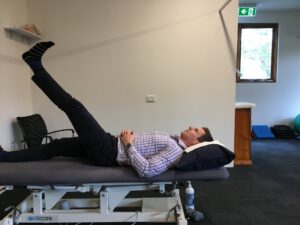What is Sciatica?
Sciatica is a broad term used to describe nerve-related pain at the back of the leg. The term stems from the sciatic nerve which is formed in the lower back from nerves that exit at the L4, L5, S1, S2 and S3 levels. It is the thickest and longest nerve in the body as it supplies the entire posterior thigh (buttock and hamstring) and the entire lower leg below the knee. The term Sciatica refers to pain originating from the sciatic nerve. So this can mean any nerve-related pain in the buttock, hamstring or anything below the knee. The sounds pretty broad right? And it is. With the recent advancements in clinical research and theories surrounding nerve pain, having a diagnosis of sciatica simply doesn’t cut it.
Nerve pain can be separated into 2 distinct groups, with different signs and symptoms in each group.
- Nerve Compression . This, as the name suggests, is as a result of the nerve being compressed somewhere along its path, most commonly as the nerve exits the spine. When a nerve is compressed, its ability to conduct normal signals is REDUCED. The symptoms associated with this are numbness (reduced sensation) pins and needles (altered sensation), weakness (reduced motor signals) and decreased reflexes. The compression occurs due to narrowing of the neural foramen (the gap between each spinal segment where nerves exit). Things like disc bulges, osteophytes, scoliosis, swelling as well as movements including extension (arching backwards) and side bending (lateral flexion) and rotation can all reduce the size of the foramen and increase the compression. Movements that open or stretch the area will often be relieving, such as bringing the knees to the chest.
- Nerve sensitisation . This presents with quite different symptoms to a nerve compression and is often more painful as well. The nerve can become very sensitive to being stretched and as a result, movements that aggravate nerve compression will often be relieving for a sensitisation. For example, lumbar extension will cause an increase in compression (which can aggravate a compressive problem) but shorten the nerve (which can relieve a sensitisation). A nerve can become sensitised from being overstretched (either acutely due to an awkward movement or chronically due to poor postural habits/abnormal movement patterns) or as a result of inflammation from nearby structures.
NOTE: A patient can often have both a compression and sensitisation concurrently. If this is the case then it is much more important to focus on the nerve compression.
Nerve Pain Assessment
There are some classic signs and symptoms we look for when assessing nerve pain. The symptoms can include, sharp pain, burning pain, shooting pain, itchiness, pins and needles, numbness and weakness. If a patient reports some or all of these symptoms we can be fairly certain that there pain may be nerve-related but we cannot be sure what type of nerve pathology it is, or what might be causing it.
The assessment needs to involve a thorough history of what the aggravating and easing factors are (outlined above), followed by a comprehensive physical assessment.
Physical Tests
-
Straight Leg Raise test (Figure 1) . This test has been shown in the literature (Mkumbuzi 2012, Capra 2011) to be a very sensitive test for sciatica and nerve pain in the back of the leg. The test is performed with the patient lying on their back, the knee is extended and the ankle dorsiflexed (toes pulled towards you) to place tension through the entire nerve. The leg is then raised until the patient reports tightness and the angle of the leg is measured. If there is more than a 5 degree difference between the affected leg and good leg AND the test reproduces the patients symptoms then it is considered a positive test for sciatic nerve involvement.
-
Bent Knee Hamstring Stretch (Figure 2). We can differentiate sciatic nerve tightness from hamstring tightness by reducing the dorsiflexion (by pointing the toes, as the sciatic nerve runs all the way to the big toe) at the ankle, bending the knee slightly and flexing the hip more. If the pain is changed/alleviated in this position then we can be confident that the pain and tightness is arising from the sciatic nerve and not from the hamstring muscles.
-
Lumbar spine range of motion assessment. As stated earlier, aggravating movements of the lumbar spine can give us a good indication of whether or not the patient is suffering from a nerve compression or a nerve sensitisation. For instance, extension (arching back) will generally increase symptoms in those with nerve compression and decrease ,or not affect symptoms, in those with a sensitised sciatic nerve.
-
Neurological examination. Includes strength tests, skin sensation testing and reflexes. These tests will only have positive findings (reduced strength, sensation) in those will a nerve root compression.
-
Other tests can include: functional movement assessment i.e. walking, squatting etc, palpation assessment of lumbar facet joints and pelvis and hip strength and range of motion assessment.
If we can categorise your nerve pain accurately, and determine the underlying cause of why the nerve is being compressed or irritated, then we have a much better chance of applying the right intervention and getting a good result.
If you are suffering from sciatic nerve pain then please consult an experienced physiotherapist.

B.Sp.Ex.Sc.,M.Physio.,Cert.Spinal.Man.Tpy., APAM
Andrew Clark is a father of 3 and the owner and principal physiotherapist at Clinical Physiotherapy, St Ives. He graduated with a Masters degree from the University of Sydney in 2010 and has since had 10 years experience working in musculoskeletal private practice. He has undergone extensive professional development and has experience treating a wide variety of patients and musculoskeletal conditions.


